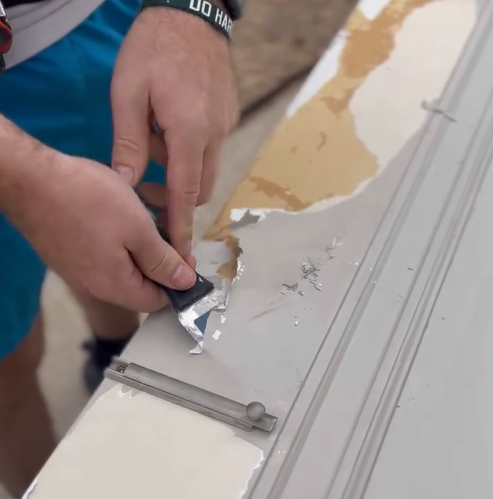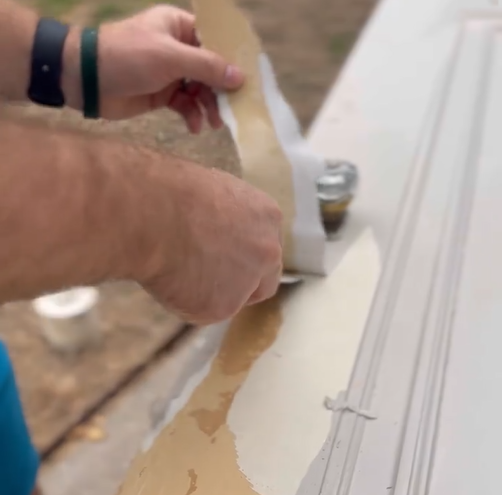
Simple Steps to Stripping Paint off a Door with Confidence
Learn effective strategies for safely stripping paint off a door. From chemical strippers to heat guns, discover methods to refresh your door’s appearance without damaging its surface.

Simple Steps To Stripping Paint off a Door
Does your door need a fresh look? But the layers of old paint are standing in the way of your renovation dreams? Stripping paint off a door might seem like a daunting task. Don’t worry because, with the right strategies and techniques, you can breathe new life into your door’s appearance.
Whether you’re restoring a vintage find or giving your home a modern update, exploring various paint removal methods allows you to achieve professional-looking results without damaging the door’s surface.
A quick warning about lead paint. Be cautious with lead paint, commonly used before 1978 and harmful if disturbed. Test for lead on surfaces with a kit before removal. If present, hire professionals or use specific removal techniques to limit exposure. Always wear protective gear like respirators and gloves, ensure good ventilation, and dispose of lead waste according to local laws.
Chemical Strippers
Chemical paint strippers are a popular choice for removing multiple layers of paint from doors. Apply the stripper according to the manufacturer’s instructions, allow it to penetrate the paint layers, and then use a scraper to remove the softened paint. Opt for low-VOC or eco-friendly strippers for a safer and more environmentally friendly option.
Heat Guns
Heat guns provide a fast and efficient way to soften paint layers, making them easier to scrape off. Use the heat gun at a safe distance from the door’s surface to avoid scorching or damaging the wood. Once the paint bubbles up, gently scrape it away with a putty knife or scraper. Exercise caution when using heat guns, especially near flammable materials, and wear appropriate protective gear to prevent burns.
Sanding
Sanding is a traditional method for removing paint from doors, especially when dealing with small areas or intricate details. Use coarse sandpaper or a power sander to gradually sand away the paint layers until you reach the bare wood surface. Take care not to over-sand or damage the door’s contours and edges.

Lead Paint Encapsulation
If you believe your door has lead paint, it’s crucial to take extra precautions to avoid lead exposure. Instead of removing the paint entirely, consider encapsulating it by applying a special primer designed to seal in lead particles. This method creates a barrier between the lead paint and the environment, reducing the risk of lead exposure while preserving the door’s integrity.
Dustless Sanding Systems
For a safer and cleaner paint removal process, consider using a dustless sanding system equipped with a HEPA vacuum. These systems capture and contain dust particles generated during sanding, minimizing airborne pollutants and reducing the risk of respiratory issues. Dustless sanding systems are particularly beneficial when working with lead paint or in enclosed spaces where ventilation may be limited.
Can I repaint the door immediately after stripping the paint, or should I wait?
After stripping the paint from your door, it’s generally advisable to wait before applying a new coat of paint. The duration of this waiting period depends on the method used for paint removal and the condition of the door’s surface. If you’ve used a chemical stripper, thoroughly clean the surface to remove any residue and allow it to dry completely before proceeding. Similarly, if you’ve opted for heat guns or sanding, ensure the surface is free of dust and debris before priming and painting. In some cases, it’s recommended to wait at least 24 to 48 hours to ensure that the surface is fully dry and ready to accept new paint. Rushing the repainting process may compromise the adhesion and durability of the new paint layer, so exercising patience ensures a smoother and longer-lasting finish for your door.
Are there any alternative methods for dealing with lead paint if professional assistance isn’t an option?
If professional assistance isn’t an option for dealing with lead paint, there are alternative methods available to minimize exposure and safely manage the situation. One approach is encapsulating the lead paint by applying a specialized encapsulating primer over the existing paint layers. This primer forms a durable barrier that seals in the lead particles, preventing them from becoming airborne or leaching into the environment. Additionally, practicing meticulous cleaning and maintenance routines can help mitigate the risks associated with lead paint. Regularly wet wiping surfaces, vacuuming with HEPA filters, and keeping areas where lead paint is present well-maintained can reduce the likelihood of lead dust contamination.
Leave a Reply
I create some affiliate links through the Amazon Influencer program and the LTK platform. Because of this, I have the ability to earn small commissions from some purchases that you make while using my links (at no cost to you!). I so appreciate your support.





